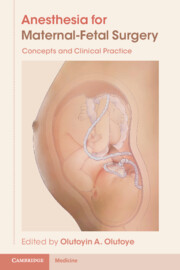Book contents
- Anesthesia for Maternal-Fetal Surgery
- Anesthesia for Maternal-Fetal Surgery
- Copyright page
- Dedication
- Contents
- Contributors
- Abbreviations
- Preface
- Acknowledgments
- Section 1
- Chapter 1 Physiology of Pregnancy
- Chapter 2 Fetal Physiology and Fetal Pain
- Chapter 3 Ethical Considerations for Maternal-Fetal Surgery
- Chapter 4 Multidisciplinary Approach to Fetal Surgery
- Chapter 5 Intrauterine Transfusion
- Section 2
- Section 3
- Index
- Endmatter
- References
Chapter 4 - Multidisciplinary Approach to Fetal Surgery
from Section 1
Published online by Cambridge University Press: 19 November 2021
- Anesthesia for Maternal-Fetal Surgery
- Anesthesia for Maternal-Fetal Surgery
- Copyright page
- Dedication
- Contents
- Contributors
- Abbreviations
- Preface
- Acknowledgments
- Section 1
- Chapter 1 Physiology of Pregnancy
- Chapter 2 Fetal Physiology and Fetal Pain
- Chapter 3 Ethical Considerations for Maternal-Fetal Surgery
- Chapter 4 Multidisciplinary Approach to Fetal Surgery
- Chapter 5 Intrauterine Transfusion
- Section 2
- Section 3
- Index
- Endmatter
- References
Summary
The focus of this chapter is to discuss a multidisciplinary approach to maternal-fetal patients undergoing minimally invasive (shunt or fetoscopic) procedures, open fetal surgery, or the ex-utero intrapartum therapy (EXIT) procedure. The team requires a diverse group of personnel. We will discuss the nature of this team and the pertinent aspects of the preoperative, intraoperative, and postoperative phase of care for the maternal-fetal patient. The preparation required for the team members providing care for these patients as well as the long-term follow-up and research aspects are outlined. Comprehensive expert care for these interventions requires administrative, institutional, research, and philanthropic support.
Keywords
- Type
- Chapter
- Information
- Anesthesia for Maternal-Fetal SurgeryConcepts and Clinical Practice, pp. 45 - 63Publisher: Cambridge University PressPrint publication year: 2021



